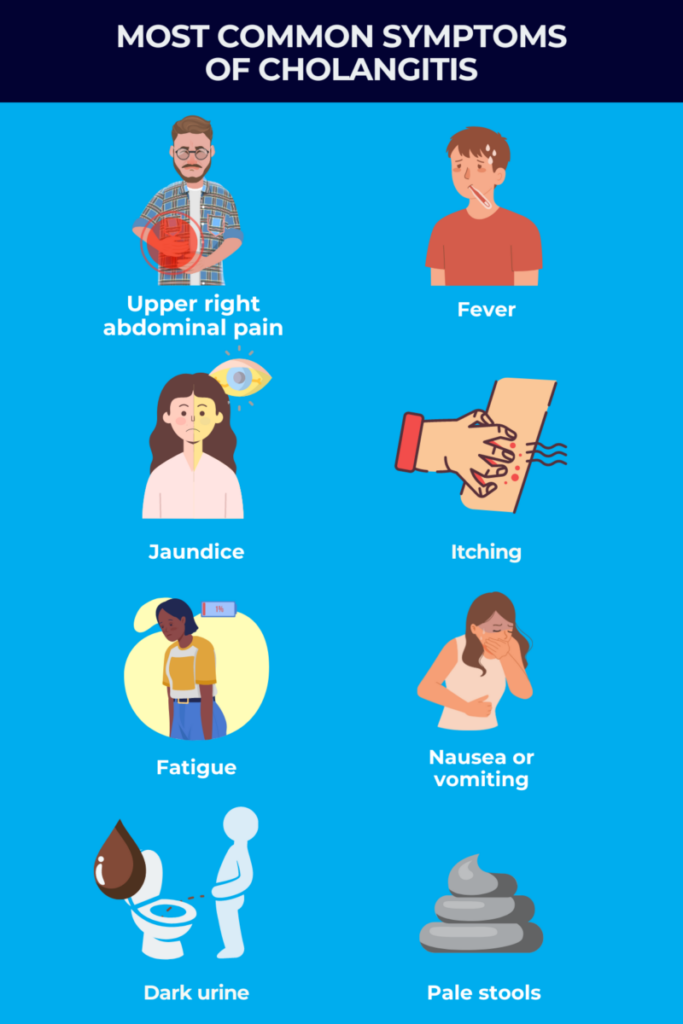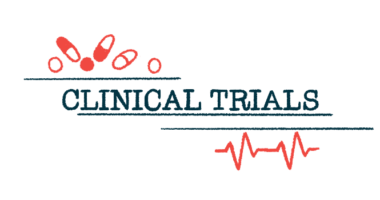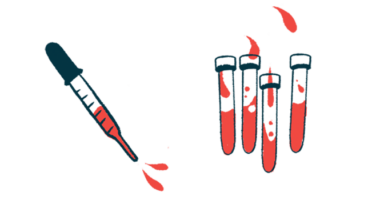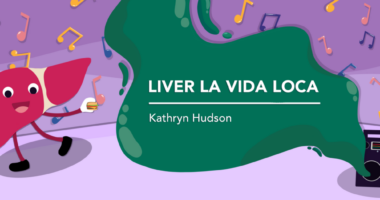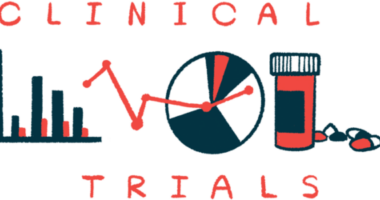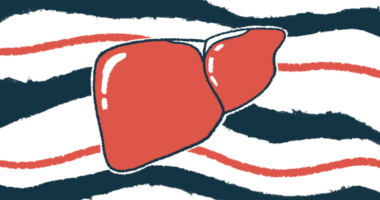Cholangitis symptoms
Last updated Sept. 26, 2024, by Lindsey Shapiro, PhD

The most common symptoms of cholangitis, a condition characterized by inflammation in the tubes that transport the digestive fluid bile from the liver to the intestines, include abdominal pain, fever, jaundice, which is a yellowing of the skin and eyes, itchy skin, and fatigue.
Cholangitis most often results from a bacterial infection in the bile ducts, but there are a number of other possible causes, including tumors and autoimmune diseases. Depending on the specific cause, cholangitis symptoms can occur suddenly, called acute cholangitis, or more subtly over the long term (chronic cholangitis).
Some overlapping signs and symptoms of cholangitis are seen in all forms of the condition, but its underlying cause may influence the type and severity of symptoms. Most symptoms of cholangitis result from abnormal bile flow and bile accumulation in the liver that causes damage to the organ.
As with most liver diseases, accurately identifying cholangitis signs as early as possible is essential to receiving prompt treatment. This can potentially avoid some of the more serious or life-threatening consequences of the disease, including whole-body infection and liver failure.
Common symptoms of cholangitis
Bile duct inflammation and swelling can lead to stalled bile flow, or cholestasis. This can result in the toxic accumulation of bile in the liver, causing organ damage and allowing bile to leak into the bloodstream, which together drive most symptoms of cholangitis.
The most common cholangitis symptoms include:
- pain on the upper right side of the abdomen
- fever and chills
- jaundice
- itchy skin
- nausea and vomiting
- dark urine and pale stools
- fatigue.
Pain
Pain is a common symptom experienced by many with cholangitis. It is usually felt on the upper right side of the abdomen, where the biliary system is located, but can also occur in the back or below the right shoulder blade. Cholangitis-related pain may come and go, and can feel either sharp, cramp-like, or dull. In acute forms of cholangitis, this pain may emerge suddenly.
Pain related to a bile duct obstruction is known as biliary colic, and often occurs after eating a large or fatty meal. After such a meal, an organ called the gallbladder, which is located under the liver and stores bile until it’s needed for digestion, will try to release bile into the intestines. But if there’s a blockage, the bile will push against that obstruction and cause pressure and pain.
Fever and chills
Fever and chills may occur in people with cholangitis as an immune system response to an infection, which is the most common cause of acute cholangitis. The blocked bile flow that some people with cholangitis experience can lead to secondary infections, so fever may also occur even if the initial cause of the cholangitis is not an infection.
Jaundice
Jaundice is a common symptom observed in people with all forms of cholangitis. It results from the liver’s inability to properly excrete bilirubin, a yellow-reddish waste product formed from the breakdown of red blood cells, through bile. This impairment leads to increased bilirubin levels in the blood, causing it to leak into neighboring tissues and tint yellow the skin and white parts of the eyes.
Itchy skin
Itchy skin, or pruritus, is one of the most common symptoms of cholestasis, a condition that often occurs in people with cholangitis. It is thought to be the result of accumulating levels of bile components in the blood and skin. Pruritus can be felt in the whole body, or can be more pronounced in certain areas, such as the hands, feet, arms, or legs. Its severity can vary from patient to patient, but can significantly affect a person’s life, sleep, and mental health when it’s severe.
Nausea and vomiting
A failure of bile to travel properly into the intestines can lead to problems absorbing fatty foods and other vitamins. This may lead to digestive issues that, combined with the liver’s reduced ability to eliminate toxins from the body, can cause nausea and vomiting. Pressure and pain related to biliary colic can also contribute to these symptoms.
Pale stools and dark urine
Changes in urine and stool color are a common symptom of cholangitis. They are also associated with the body’s inability to properly eliminate bilirubin through feces. As bilirubin metabolization in the intestines is what gives stools their usual brown color, bilirubin’s inability to reach the intestines can make stool look lighter than normal, white, or clay-colored.
In turn, because bilirubin is not excreted through feces and instead builds up in the bloodstream, it is transported to the kidneys to be excreted, leading to darker than usual, amber, or brown-colored urine.
Fatigue
Fatigue is one of the most common and debilitating chronic cholangitis symptoms. Although the underlying cause of fatigue in cholangitis remains largely unclear, it is thought to be associated with poor sleep and changes in the nervous system.
Other possible symptoms
People with cholangitis can also experience a range of other symptoms, depending on the disease’s cause, severity, and how far it has progressed. These may include:
- Malaise due to an infection in the bile ducts
- Deficiency of fat-soluble vitamins such as vitamins A, D, E, and K due to impaired absorption in the intestines, which may result in symptoms such as malnutrition, failure to thrive for infants and children, weak bones, or easy bleeding
- Appetite and weight loss due to digestive issues
- Hepatic encephalopathy, or mild cognitive impairment due to the buildup of toxins in the bloodstream that affect brain function
- Portal hypertension, or high blood pressure in the portal vein that transports blood from the gastrointestinal system to the liver, which can lead to an enlarged liver or spleen, spider veins (red, spider-like blood vessels under the skin), swollen veins in the esophagus or abdomen (gastrointestinal varices), and fluid buildup in the abdomen (ascites).
Without treatment, both acute and chronic forms of cholangitis can lead to liver failure.
Do cholangitis symptoms vary by disease type?
While several symptoms can overlap between acute and chronic forms of cholangitis, including abdominal pain, fever, jaundice, and pruritus, they may not occur in the same timing and order. Unlike acute cholangitis, where symptoms typically appear suddenly, chronic cholangitis symptoms tend to develop more slowly over time and cholangitis signs may initially be subtle.
Moreover, certain symptoms may be more specific to acute cholangitis and others exclusive to chronic forms of cholangitis, such as primary biliary cholangitis (PBC) and primary sclerosing cholangitis (PSC).
Both PBC and PSC are common forms of chronic cholangitis believed to arise from an underlying autoimmune disease, and there is some overlap between biliary cholangitis symptoms and sclerosing cholangitis symptoms. People with either disease may not even notice any autoimmune cholangitis symptoms until liver damage has substantially accumulated.
Acute cholangitis symptoms
Acute cholangitis, also known as ascending cholangitis, is a life-threatening condition typically caused by a bacterial infection that occurs secondary to an obstruction in the bile ducts. This blockage in bile flow can be caused by gallstones, that is, hardened deposits of bile that form in the gallbladder and then obstruct the bile ducts, or tumors.
The most common symptoms of acute cholangitis are known as Charcot’s triad and include:
- upper right abdominal pain
- fever
- jaundice.
These ascending cholangitis symptoms tend to come on quickly and are very noticeable. As infection-related cholangitis becomes more severe, patients may experience additional symptoms of ascending cholangitis, including pruritus, confusion, or disorientation.
Should an underlying infection reach the bloodstream, a life-threatening medical condition called sepsis may occur. This is the body’s extreme response to a body-wide infection, and may include symptoms such as fast heart rate and low blood pressure.
In acute cholangitis, experiencing Charcot’s triad in addition to confusion and signs of septic shock is called Reynold’s pentad. This combination of five symptoms is a sign that cholangitis has become critical and is a medical emergency.
In general, if treated promptly, acute cholangitis signs and symptoms will subside once the underlying cause of inflammation or bile duct blockage has been addressed.
Symptoms of ascending cholangitis may overlap with those of pancreatitis, that is, inflammation in the pancreas, which is another complication of gallstones.
Some people with chronic forms of cholangitis can also experience periods of sudden, new or worsening cholangitis symptoms, called cholangitis flares or attacks, that are similar to acute cholangitis symptoms. These flares can be caused by infections, so symptoms of a cholangitis attack may look similar to bacterial cholangitis symptoms in that they may come on quickly and get better when the underlying cause is treated.
Primary biliary cholangitis symptoms
PBC progressively affects the bile ducts within the liver. The earliest and most common primary biliary cholangitis symptoms are:
- fatigue
- pruritus.
In turn, later symptoms of primary biliary cholangitis may include:
- jaundice
- abdominal pain
- bone, muscle, or joint pain
- deficiency of fat-soluble vitamins and its related symptoms
- problems related to poor absorption of fatty molecules, including fatty poop or diarrhea, high levels of the fatty molecule cholesterol in the blood, and deposits of cholesterol underneath the skin called xanthomas
- darkening of the skin
- portal hypertension and its associated complications
- hepatic encephalopathy.
Primary sclerosing cholangitis symptoms
Distinct from PBC, PSC affects the ducts both inside and outside the liver. Primary sclerosing cholangitis early symptoms include:
- fatigue
- pruritus
- abdominal discomfort or pain.
Later on, primary sclerosing cholangitis symptoms may include:
- fever and chills due to infection in the bile ducts
- jaundice
- enlarged liver or spleen
- problems related to fat and fat-soluble vitamin malabsorption
- ascites, or swelling of the abdomen from a buildup of fluid
- hepatic encephalopathy
- gastrointestinal varices
- weight loss.
Most primary sclerosing cholangitis symptoms overlap with those observed in PBC, as many are related to progressively worsening liver disease causing irreversible scarring (cirrhosis).
Secondary sclerosing cholangitis is another form of chronic cholangitis that usually occurs as a consequence of surgery complications, longstanding bile duct obstructions, or other factors. Secondary sclerosing cholangitis symptoms are generally similar to primary sclerosing cholangitis signs.
Liver Disease News is strictly a news and information website about the disease. It does not provide medical advice, diagnosis or treatment. This content is not intended to be a substitute for professional medical advice, diagnosis, or treatment. Always seek the advice of your physician or other qualified health provider with any questions you may have regarding a medical condition. Never disregard professional medical advice or delay in seeking it because of something you have read on this website.
Recent Posts
- Nebokitug reduces immune cell activity that drives PSC: Data
- New biomarkers may help detect pregnancy-linked liver complication
- Access to food is a survival tactic when your liver needs nutrition
- Belapectin may help reduce liver scarring in those with severe MASH
- Parents and son are all on a path of discovery with Alagille syndrome
Related articles
